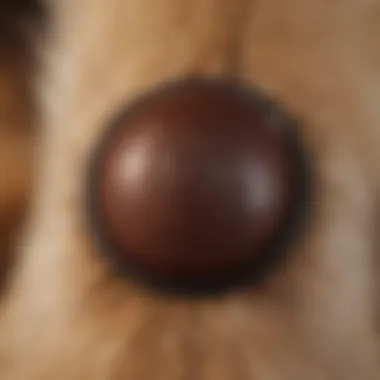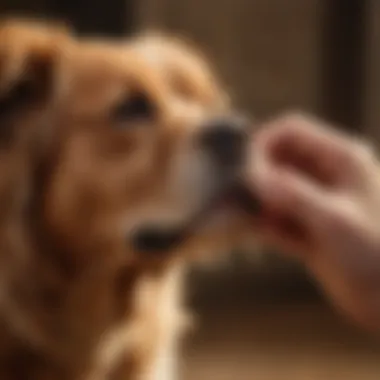Effective Methods for Removing Ticks from Dogs Safely


Intro
Ticks are small arachnids that can pose serious health risks to dogs. Their presence can result in various diseases, such as Lyme disease, Rocky Mountain spotted fever, and more. Understanding effective methods for removing ticks from your canine companion is essential for maintaining their health. With the right techniques and tools, you can safeguard your dog from infections that ticks may transmit.
In this guide, we will explore several important aspects of tick removal. We will dive into proper techniques, the necessary equipment, and aftercare protocols. Furthermore, we will address some common misconceptions surrounding tick removal practices. This comprehensive overview is tailored for all dog owners, whether you are experienced or new to the management of ticks.
Fascinating Facts About the Animal
Unique Characteristics
Ticks are not insects; they belong to the arachnid class, which also includes spiders and scorpions. A tick's life cycle consists of four stages: egg, larva, nymph, and adult. Interestingly, they can live between several months to a few years, depending on environmental conditions.
Extraordinary Abilities
Ticks have specialized mouthparts that allow them to latch onto their hosts firmly. Their ability to detect carbon dioxide and body heat aids them in finding potential hosts. Despite their small size, ticks can be remarkably resilient.
Behavior and Habitat
Natural Habitats
Ticks thrive in warm, moist environments. Common places where they are found include wooded areas, tall grasses, and dense shrubbery. They are most active during the warmer months, which increases the risk for pets that spend time outdoors.
Social Structures
Ticks do not exhibit social behaviors like other animals. They are solitary creatures. Their reproductive habits involve the female feeding on blood and then laying thousands of eggs in environments conducive to tick survival.
Recent Scientific Discoveries
Latest Research Findings
Recent studies have expanded understanding about tick-borne diseases. Researchers are investigating how these parasites affect host organisms and the mechanisms behind disease transmission.
Breakthroughs in Animal Biology
Advancements in technology have facilitated the study of tick genetics and biology. Findings are leading to new strategies in veterinary medicine to manage tick populations and prevent disease transmission.
Cultural Significance
Animals in Folklore
Ticks are often overlooked in cultural narratives. However, some cultures associate ticks with various meanings, often viewing them as pests and symbols of disease.
Influence on Art and Literature
Although ticks themselves are rarely depicted, the broader implications of pestilence can be found in various forms of art and literature, signifying the struggle between humans, animals, and disease.
"Understanding the biology and behavior of ticks is crucial for effective prevention and management of tick-borne diseases in dogs."
Effective tick management is more than just removal. It encompasses awareness, prevention, and safe practices to ensure a healthier life for your pets. As we progress, we will delve into the actual methods for safely and effectively removing ticks from dogs.
Understanding Ticks and Their Impact on Dogs
Ticks are more than just minor nuisances in the lives of dogs. Understanding their biology, their common types, and the diseases they transmit is critical for responsible pet ownership. When ticks attach to dogs, they can cause a variety of health issues. Knowledge about ticks helps in prevention and proper removal, which reduce the risk of serious infections.


What Are Ticks?
Ticks are small, parasitic arachnids that feed on the blood of their hosts, which can include dogs, cats, and humans. These creatures belong to two main families: hard ticks and soft ticks. Hard ticks, notable for their oval shape and scutum, are largely responsible for disease transmission. They have a life cycle that includes four stages: larva, nymph, adult, and engorged tick. Their quest for hosts leads them to tall grasses and wooded areas, making outdoor activities with pets a vector for tick exposure.
Common Types of Ticks Found on Dogs
Several species of ticks commonly infest dogs. Some of the most prevalent are:
- Black-legged Tick (Ixodes scapularis): Also called the deer tick, it primarily transmits Lyme disease.
- American Dog Tick (Dermacentor variabilis): Known to carry diseases like Rocky Mountain spotted fever.
- Brown Dog Tick (Rhipicephalus sanguineus): This tick can infest homes, as it prefers indoors, and is linked to various diseases that can affect dogs.
- Lone Star Tick (Amblyomma americanum): Notable for its distinctive white spot, it is known to carry several pathogens.
Understanding these ticks and their habitat helps identify risks associated with tick bites.
Diseases Transmitted by Ticks
Ticks are vectors for a range of serious diseases that affect canine health. Some critical conditions include:
- Lyme Disease: Caused by the bacterium Borrelia burgdorferi, symptoms can range from lameness to kidney issues.
- Rocky Mountain Spotted Fever: This bacterial infection can cause fever, vomiting, and even neurological disorders.
- Ehrlichiosis: Often results in fever, lethargy, and bleeding disorders in dogs.
- Anaplasmosis: Associated with lethargy and joint pain, it can impact active dogs significantly.
It is essential for pet owners to recognize these potential dangers. Understanding ticks can lead to better prevention efforts and prompt action when ticks are discovered.
Recognizing a Tick Infestation
Recognizing a tick infestation is critical for dog owners. Ticks can cause health risks to dogs, including serious diseases. The sooner you identify the presence of ticks, the quicker you can take action. This section will cover different behaviors of dogs with ticks, signs of a tick bite, and how to locate ticks on your dog.
Behavior of Dogs with Ticks
Dogs with ticks may exhibit several behavioral changes. These changes can be subtle or noticeable. A dog may become more anxious or restless. Some dogs might scratch or bite at their skin frequently. This can indicate discomfort caused by ticks. If you notice your dog is unusually lethargic, this can also be a sign. Inactive behavior may occur if the dog is in distress due to irritation or illness from the ticks.
Pay attention to how your dog behaves during walks in wooded or grassy areas. Increased agitation or frequent attempts to scratch may mean your dog has encountered ticks. Observing your dog's behavior closely can help you catch an infestation early.
Common Signs of a Tick Bite
Identifying a tick bite is crucial for taking the right steps in removal and care. Common signs include:
- Redness: Look for areas around the bite that may appear red or inflamed.
- Swelling: An increase in size near a bite can indicate irritation.
- Hair Loss: Ticks may cause patches of hair loss in the area where they attach.
- Licking: If your dog continuously licks a specific spot, this may indicate soreness or discomfort associated with a tick bite.
In some cases, dogs may develop a more severe reaction to tick bites, leading to an allergic reaction. Watch for symptoms like excessive scratching, vomiting, or diarrhea. These can indicate a more significant issue that requires veterinary attention.
Identifying Tick Locations on Dogs
Ticks often hide in specific areas of a dog's body. Common locations include:
- Ears: Inside or around the folds of the ears is a frequent hiding spot.
- Neck: Ticks may attach under collars, so examine this area carefully.
- Armpits: Check beneath the forelegs where ticks may find it easy to cling.
- Between Toes: Ticks can also attach in unnoticeable spots like the space between toes.
- Tail: The base of the tail is another common area.
To effectively identify ticks, comb through your dog's fur using your fingers. If you find any ticks, take note of where they are located. This can help you focus on areas during subsequent tick checks. Regular grooming and inspection are key to limiting the risk of tick issues for your dog.
Regular checks after walks in nature are essential for tick management. Catching them early can prevent serious health issues.
Safe and Effective Tick Removal Techniques
Removing ticks from dogs is not simply a task of urgency; it involves understanding proper methods to ensure the health and safety of your pet. Safe and effective tick removal techniques can greatly reduce the risk of infections and diseases that ticks may transmit. Utilizing the correct tools and methods promotes a smoother removal process, ensuring minimal stress for both the dog and the owner. This section will cover various techniques that are essential for proper tick removal.
Using Tweezers for Tick Removal
Choosing the Right Tweezers


Selecting the right tweezers is imperative for effective tick removal. The best tweezers are fine-tipped, straight-edged, and sturdy. These features allow for precise grip and extraction of the tick. A beneficial choice in this case is the tick removal tweezers available in pet stores. They are designed for this very purpose, providing ease in handling and effectiveness in extraction. The unique aspect of these tweezers is that they are often designed specifically to reach the tick's head without squeezing the tick's body, thus reducing the risk of infection.
How to Grip the Tick
Gripping the tick properly is crucial. It is important to grasp the tick as close to the dog's skin as possible. This method minimizes the chance of leaving the tick's mouth parts embedded in the skin. A firm but gentle grasp is key. A beneficial aspect of this approach is that it enables the owner to maintain control while removing the tick. If not gripped well, the tick can detach unevenly, which might lead to complications. Proper gripping requires practice, but mastery of this technique contributes to overall success in tick removal.
Slow and Steady Extraction
The method of slow and steady extraction cannot be understated. This technique emphasizes taking your time while pulling the tick out. Swift movements can result in the tick's body breaking apart, leaving parts behind. A key feature of this technique involves applying even, steady pressure without sudden jerks. This controlled approach enhances the likelihood of complete tick removal. Moreover, it reduces anxiety for the dog, making the procedure more comfortable.
Using Tick Removal Tools
Types of Tick Removal Devices
Different types of tick removal devices cater to diverse needs and preferences. Common options include tick forks, hooks, and specialized tick removal cards. Each device offers unique features; for instance, tick forks allow for a gentle lift and extraction, while removal cards provide an innovative way to slide under the tick. These tools can be very effective, with each device designed to prevent the possibility of leaving behind any tick parts in the skin, making them a valuable choice for dog owners.
Step-by-Step Instruction
Following a step-by-step instruction is vital to ensure proper tick removal. First, select a suitable device or tweezers. Then, gently separate the fur and position the tool around the tick. After grabbing the tick firmly, apply steady pressure upwards. Ensure to perform this process in a calm and controlled manner. Providing clear instruction guides helps pet owners feel more confident, emphasizing the importance of taking progressive steps when removing ticks.
How to Remove Ticks Safely
Cleansing the Area
Cleansing the area around the tick bite is essential post-removal. It reduces the risk of infection significantly. Use an antiseptic wipe or solution to clean the area thoroughly. This step not only helps in preventing infections but also promotes healing of the skin. It is a beneficial practice for pet care, ensuring that any remnants or bacteria are addressed swiftly and effectively.
Post-Removal Actions
After removing a tick, certain post-removal actions should be observed. Monitor the dog for signs of irritation or infection in the following days. If any unusual behavior or symptoms arise, consult a veterinarian promptly. Ensuring the pet's continued health is fundamental after tick removal. This diligent follow-up underscores the responsibility of pet owners in maintaining their dog's well-being.
Preventative Measures Against Ticks
Preventative measures against ticks are crucial for protecting dogs from tick-borne diseases. These proactive steps reduce the likelihood of infestation and are central to a comprehensive tick management strategy. Ticks can carry several infections, so emphasizing prevention helps ensure the health of the dog. The cost and effort invested in prevention are typically less than what is needed for treatment after an infestation. By incorporating regular grooming, vet visits, and preventive treatments, owners can significantly mitigate tick-related risks.
Routine Check-Ups and Grooming
Routine check-ups and grooming play a vital role in tick prevention. Regular grooming allows pet owners to physically inspect their dogs for ticks. It is advisable to examine areas where ticks are likely to attach, such as behind the ears, under the legs, and around the tail. Veterinary check-ups also help maintain a dog’s overall health and allow professionals to provide additional tick management advice. Establishing a consistent grooming routine can serve both aesthetic and health purposes, ensuring any unwanted pests are caught early.
Use of Tick Preventatives
Spot-On Treatments
Spot-on treatments are popular among dog owners for their convenience and effectiveness in preventing tick infestations. These treatments are applied directly to the skin, usually between a dog’s shoulder blades, allowing the active ingredient to spread through the skin’s oils, providing protection for several weeks. One key characteristic of spot-on treatments is their ease of application. This method minimizes stress for the dog and the owner.
Some spot-on treatments contain ingredients that repel ticks before they bite, which is a unique feature that enhances their effectiveness. However, it is essential to follow the manufacturer's instructions closely. Over-application or improper use can lead to skin irritation or inadequate protection, which highlights the importance of selecting the appropriate product for the dog’s size and weight.
Collars and Oral Medications
Collars and oral medications offer alternative methods for preventing ticks. Tick collars are designed to release chemicals that repel and kill ticks. Their primary benefit is long-lasting protection, as many collars are effective for several months. The continuous release of active ingredients poses a key advantage, providing around-the-clock protection against ticks.
Oral medications, on the other hand, work systemically. They circulate through the dog’s bloodstream, effectively killing ticks when they bite. This can be a beneficial option for dogs who may be resistant to topical treatments. However, potential side effects can occur, making it essential for owners to consult their veterinarian. Evaluating which preventative option best suits a dog’s lifestyle will help ensure optimal tick protection and overall health management.
It is critical to choose the right preventative methods as not all dogs respond positively to every product. An informed decision can make a significant difference in the effectiveness of tick prevention measures.


What to Do After Tick Removal
After successfully removing a tick from your dog, it is crucial to pay attention to what comes next. The process does not end with tick removal. Instead, monitoring your dog and taking appropriate steps afterward can prevent potential health issues. Here are the key elements to consider:
Monitoring for Signs of Infection
It is important to keep a close watch on the site of tick removal. Ticks can leave behind irritation and potential infection. Look for the following signs:
- Redness: Increased redness around the bite area can indicate inflammation.
- Swelling: Watch for any swelling, which might suggest an adverse reaction.
- Pus or discharge: Any unusual discharge should raise concerns about infection.
- Increased sensitivity: If your dog reacts when you touch the area, it may be a sign of pain.
If you notice any of these signs, a clean with antiseptic can help, but continuous observation is necessary. Minor irritation can be normal, but if it persists or worsens, it could indicate a more serious problem.
When to Consult a Veterinarian
Sometimes, signs that suggest a need for veterinary attention may not be clear. Seek professional help if:
- Symptoms appear: If your dog shows unusual symptoms like lethargy, fever, or loss of appetite. These may not be directly linked to the tick bite but can indicate a more significant issue.
- Infection seems serious: If the bite area exhibits pronounced swelling or pus. A veterinarian can evaluate the need for antibiotics or further treatment.
- Tick-related illnesses are suspected: If you know that the tick removed was a species known to carry diseases like Lyme disease or Rocky Mountain spotted fever, look out for symptoms related to those conditions.
A timely consultation with a veterinarian can ensure your dog's health and safeguard against severe complications.
Prompt reporting of any concerning signs improves outcomes.
In summary, the period after a tick removal is essential for your dog's recovery. Keep a vigilant eye on the bite site for infection signs and do not hesitate to reach out to your veterinarian when in doubt. Your proactive steps can greatly contribute to long-term health for your pet.
Myths and Misunderstandings About Tick Removal
Ticks pose real health threats, yet myths about their removal can lead pet owners astray. Understanding these misconceptions is crucial for ensuring the safety of our dogs. Misleading beliefs not only impact tick removal practices but can also influence overall dog health. Properly tackling these myths helps in implementing effective tick management strategies.
Common Misconceptions
Several common misconceptions exist regarding tick removal that can confuse pet owners. One popular myth is that applying petroleum jelly or alcohol will make the tick loosen its grip. This approach is harmful. It may stress the tick, potentially leading to an increased chance of disease transmission.
Another misconception is the belief that burning a tick with a hot match will be effective. In fact, this method is dangerous for both the tick and the dog. It risks burns and does not ensure complete removal. It can even leave parts of the tick behind, leading to further issues.
Some people believe that only certain types of ticks carry diseases. In reality, different tick species can transmit multiple diseases. Recognizing this is important for preventing health risks to dogs.
Distinguishing Fact from Fiction
Distinguishing facts from fiction regarding tick removal requires knowledge. For instance, it's a fact that ticks should be removed as soon as they are discovered. Prompt removal minimizes the risk of disease transmission. In contrast, delays can lead to serious health risks for dogs.
Effective tick management hinges on accurate information. Confusion can lead to ineffective practices, which may expose pets to unnecessary dangers.
Another key fact is the proper method of removal. Using fine-tipped tweezers or specific tick removal tools is recommended. This contrasts with the myth that any technique can suffice.
In summary, recognizing and understanding misconceptions about tick removal can help dog owners take the right actions. Implementing facts instead of myths safeguards the health of pets. Pet owners must stay informed, and always consult veterinary professionals when unsure.
Concluding Thoughts on Tick Management
Ticks pose a serious threat to the health of dogs, making ongoing management essential for pet owners. The removal process should not merely be a reaction to finding a tick; it must be part of a broader strategy aimed at prevention and care. Establishing effective methods for tick management ensures that dog owners can act swiftly and appropriately, minimizing the risks associated with tick bites and related diseases.
The Importance of Prompt Tick Removal
Removing ticks promptly is crucial. A tick can transmit harmful pathogens to your dog within hours of attachment. The longer a tick stays on, the higher the risk of infection. For this reason, regular checks and immediate removal can make a significant difference in your dog's health. Employing proper techniques reduces the chance of leaving mouthparts embedded in the skin, which can lead to additional problems, such as infections. You should always have the necessary tools on hand and know how to use them effectively.
Emphasizing Continuous Care for Dogs
Tick management is not a one-time event. It requires continuous attention, including routine check-ups and preventive measures. Regular grooming can help detect ticks early. Additionally, using veterinarian-approved preventative treatments, such as topical applications or collars, can keep ticks at bay. The collaboration between pet owners and veterinarians is essential in developing a comprehensive care plan. Take this responsibility seriously; consistent care will contribute to your dog's well-being and health.
"Preventing ticks is far easier than dealing with the consequences of a tick-borne disease."
By integrating prompt removal and ongoing care, dog owners can significantly reduce the risks associated with ticks. A proactive and informed approach not only protects dogs from immediate harm but also fosters long-term health. In the end, responsible tick management reflects a dog's overall care and owner's commitment to their well-being.







